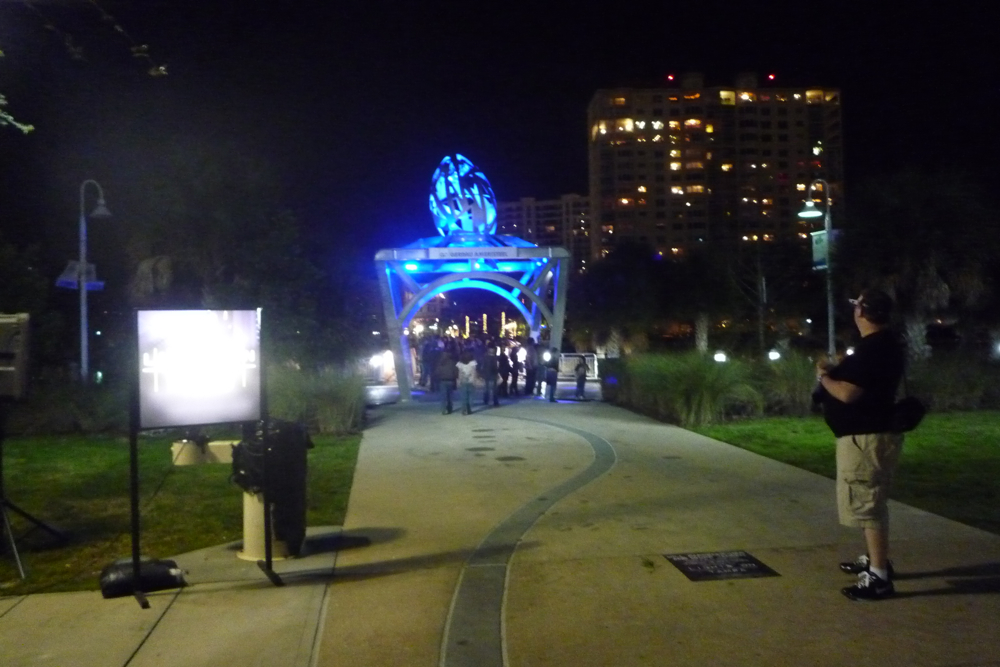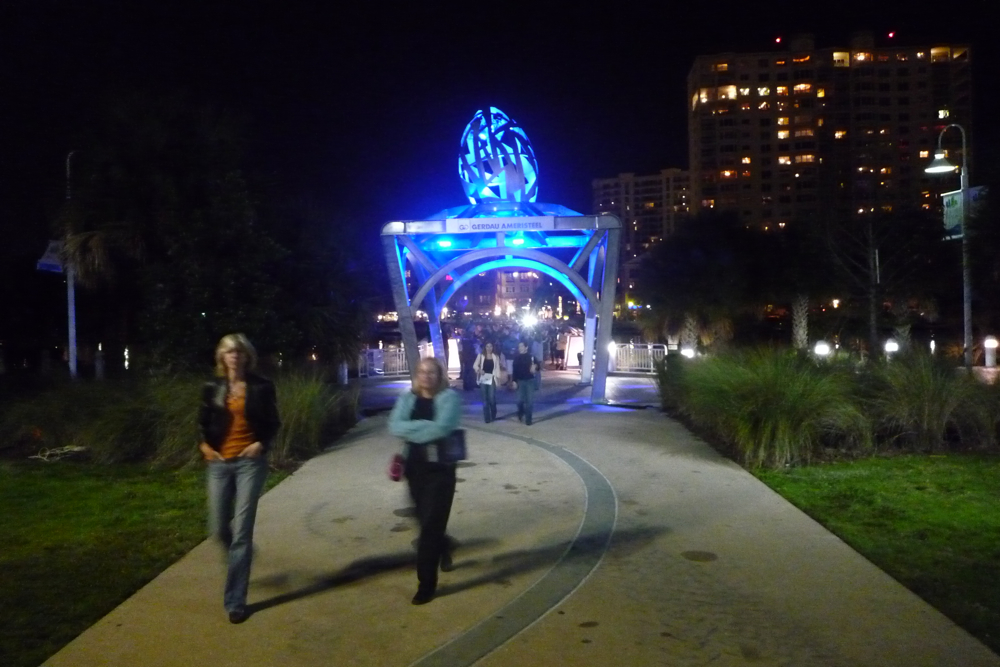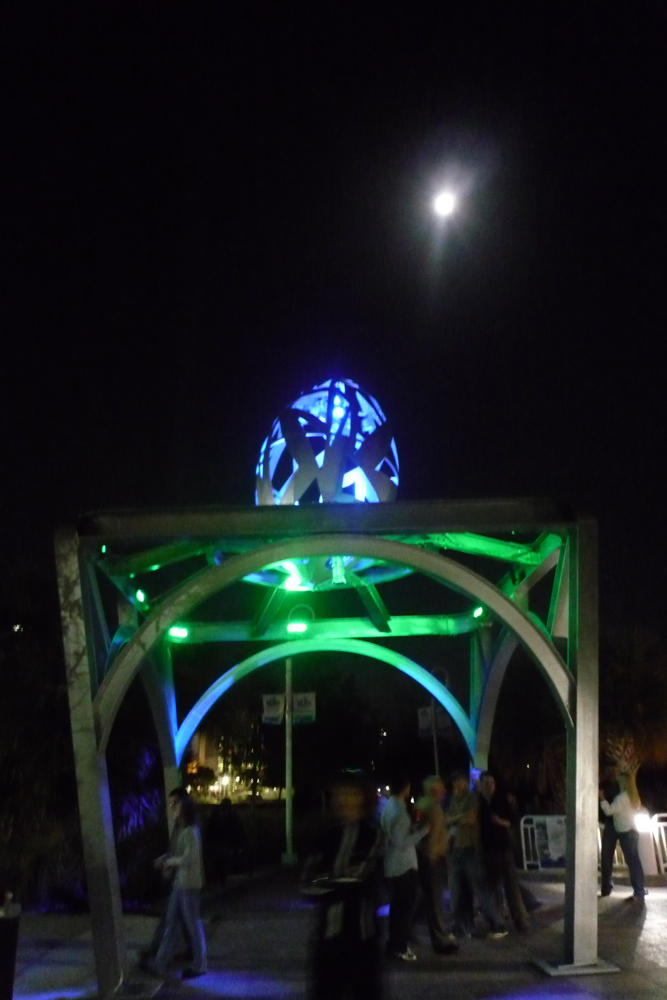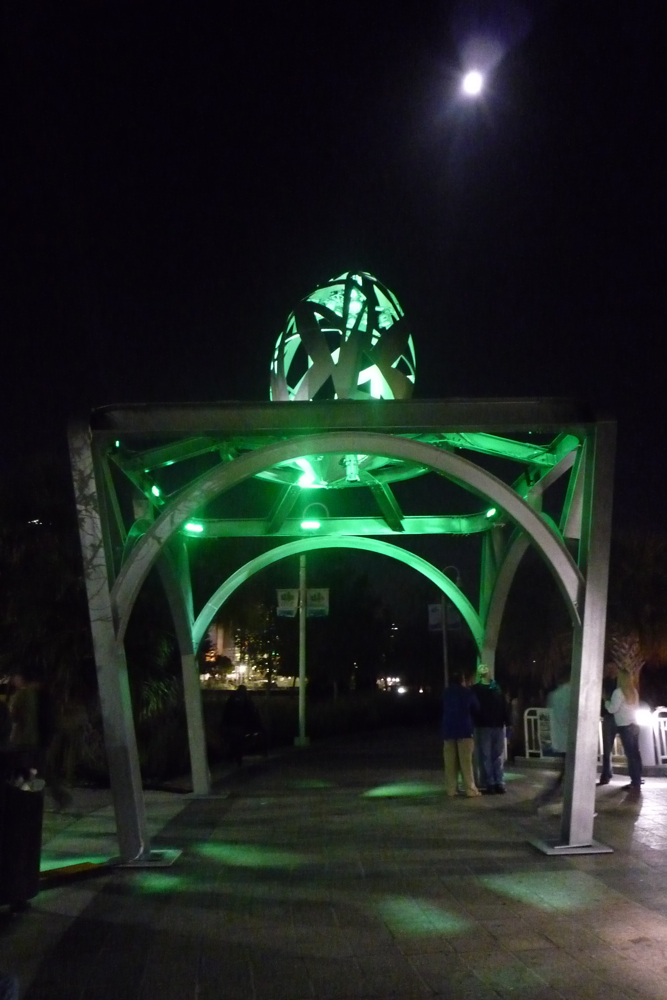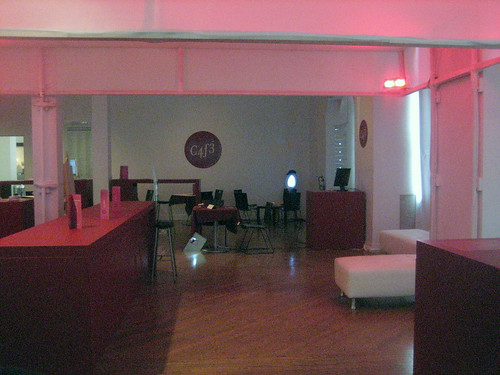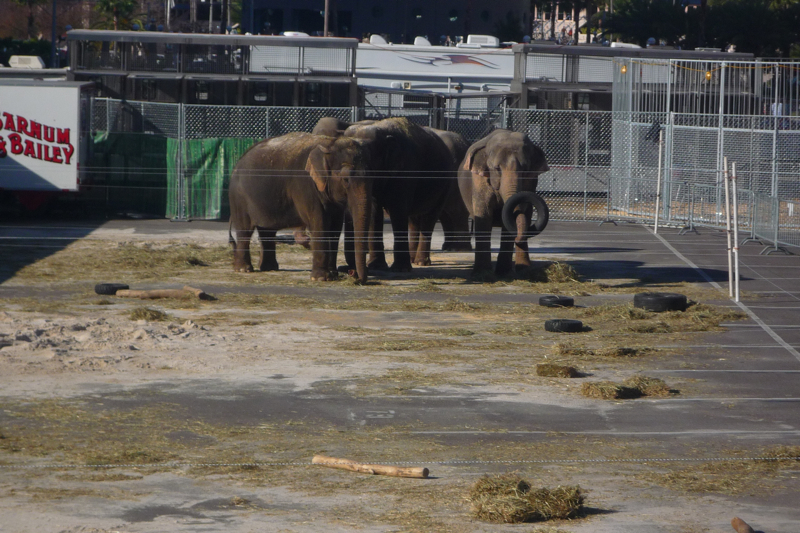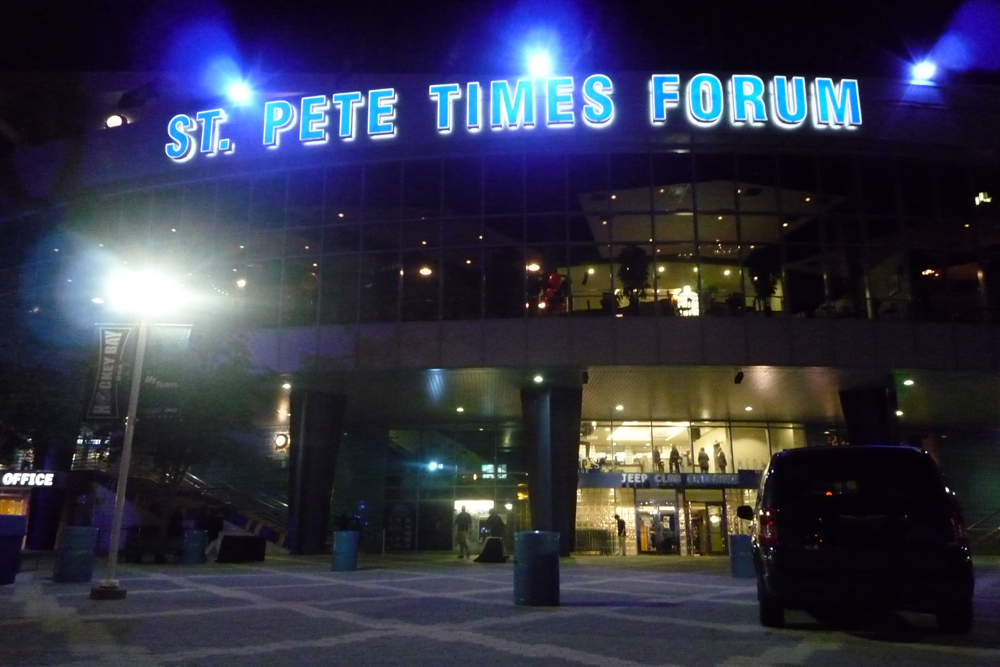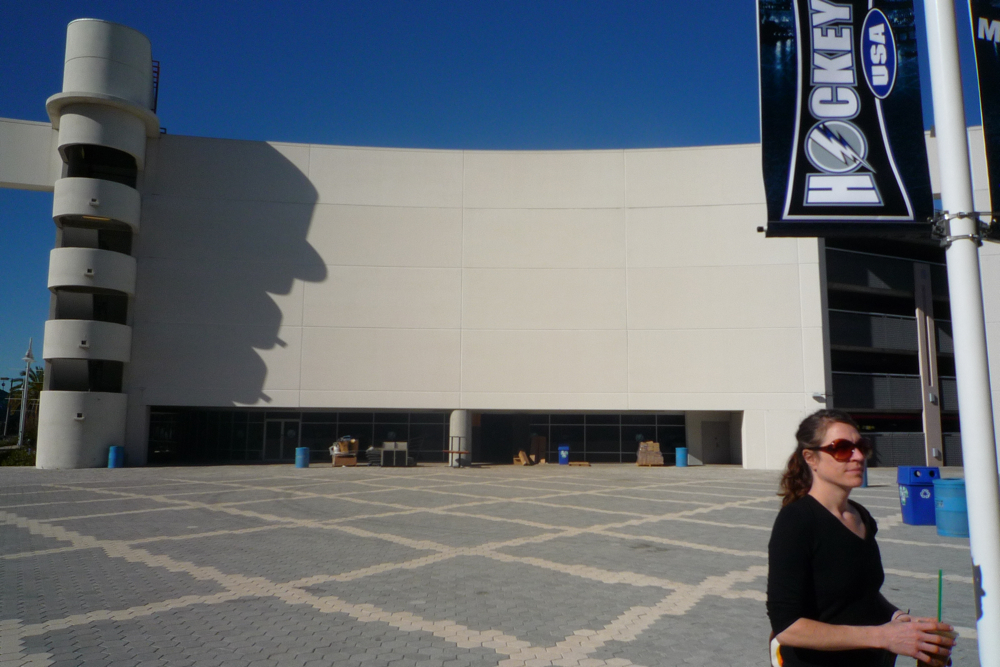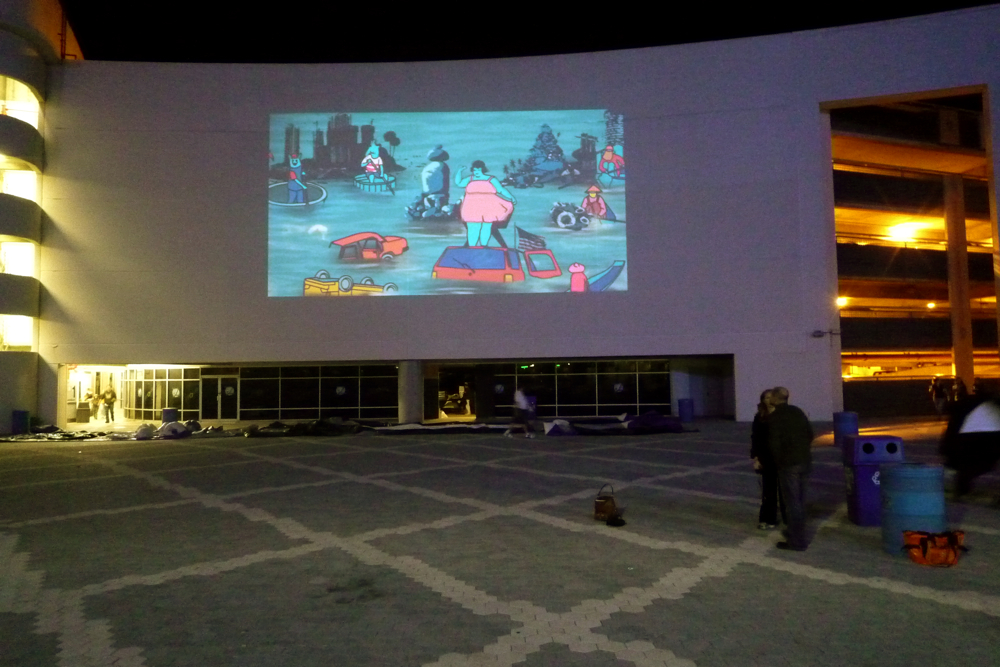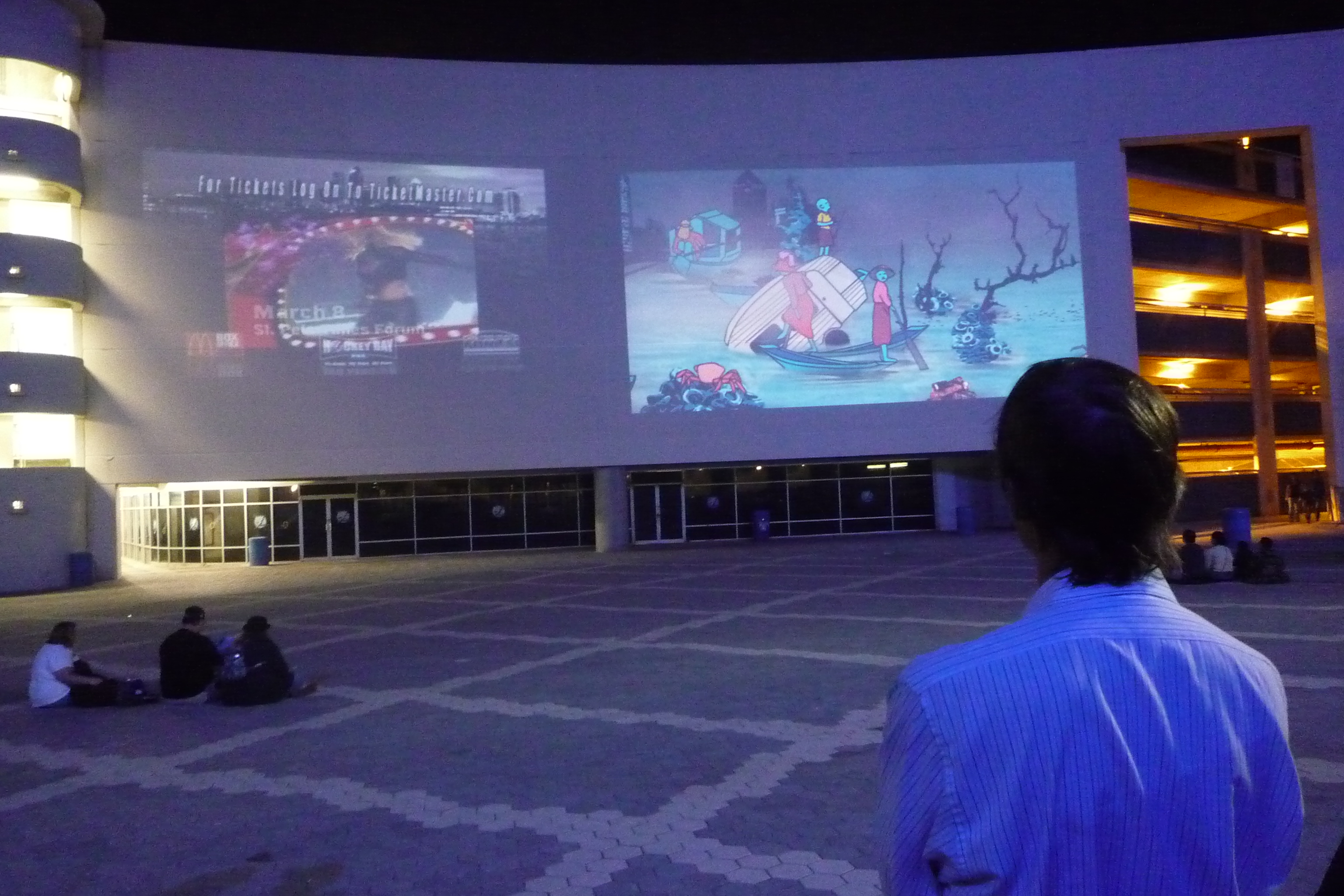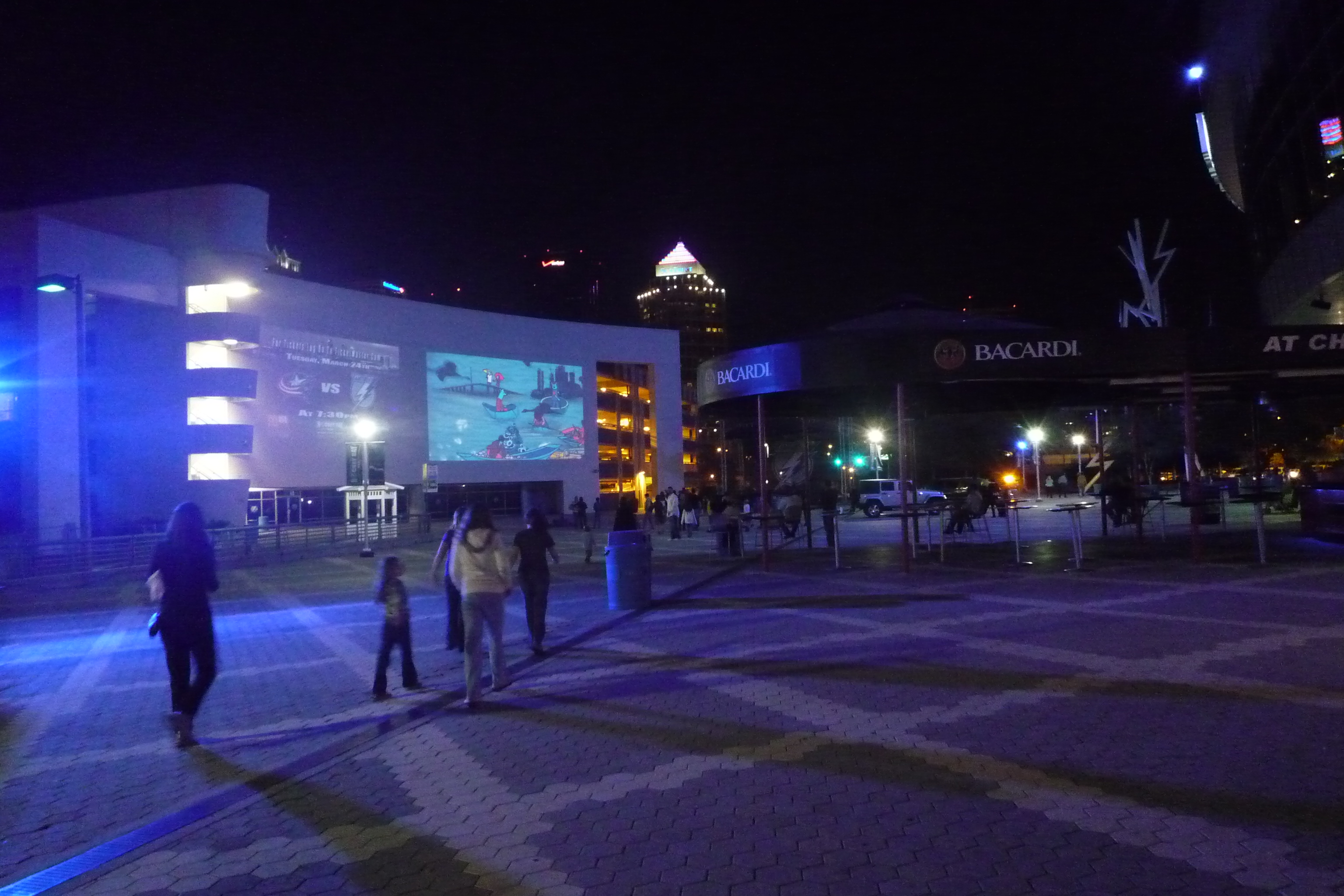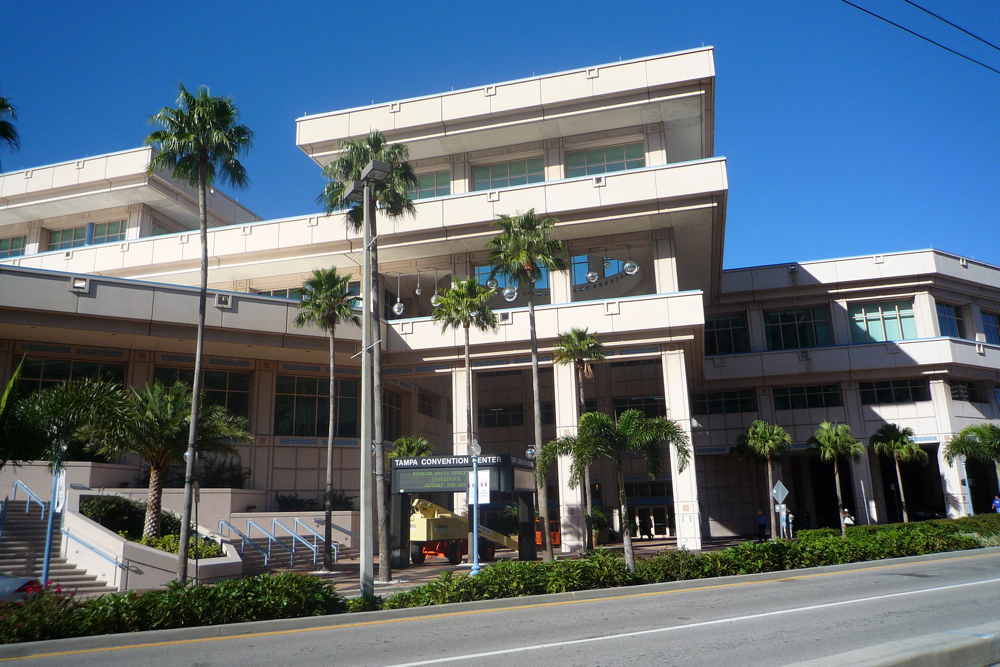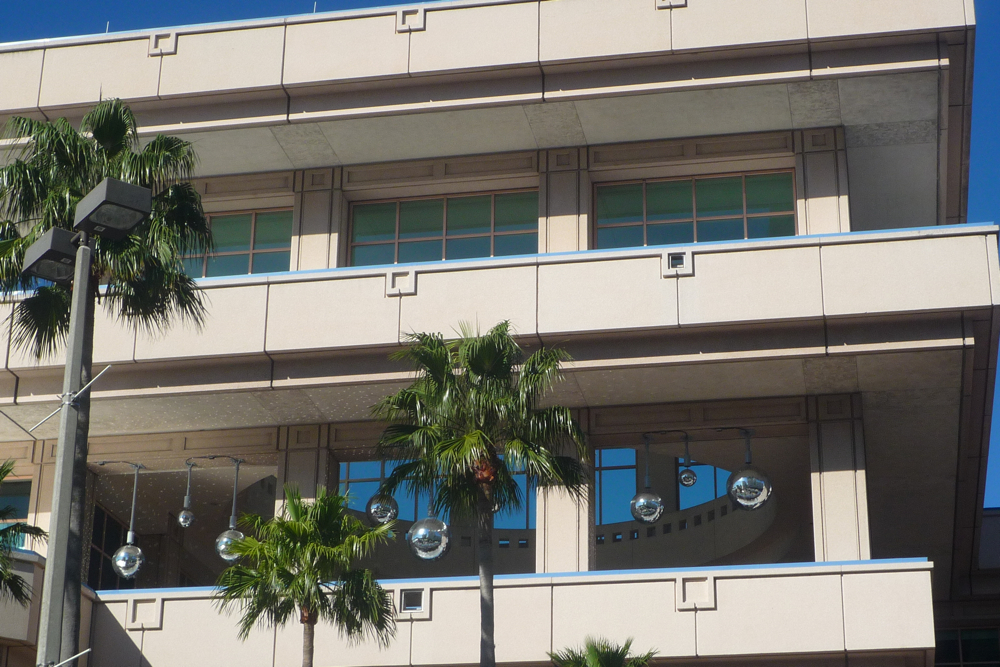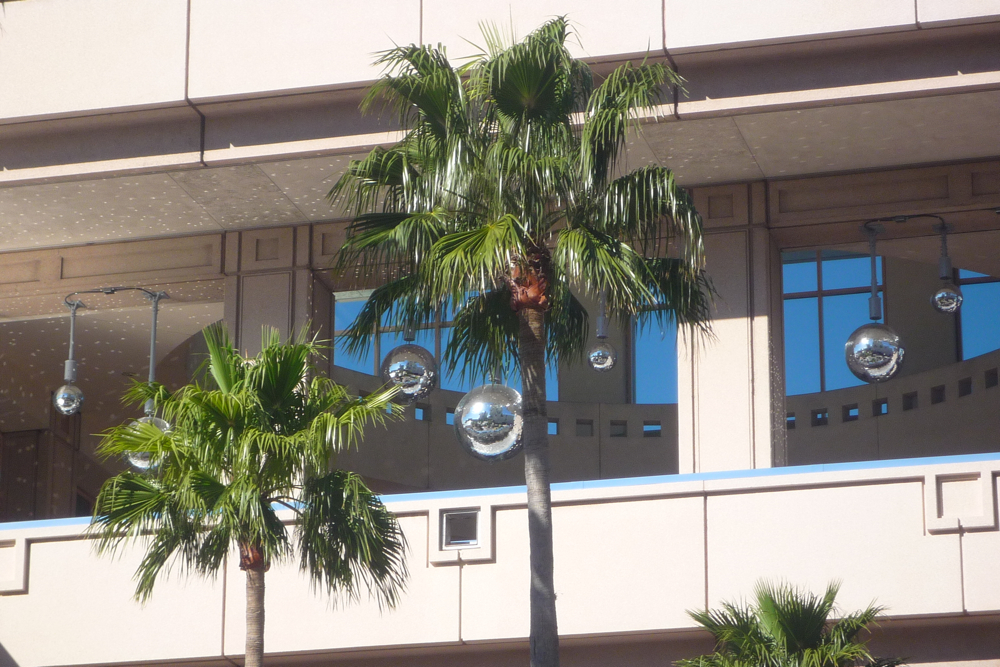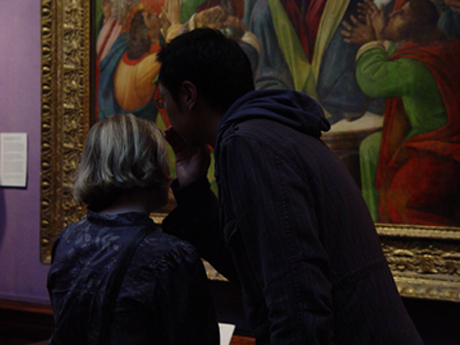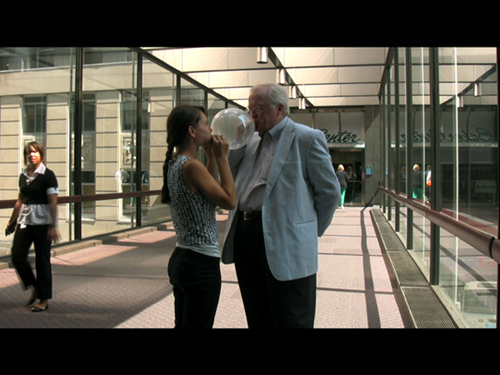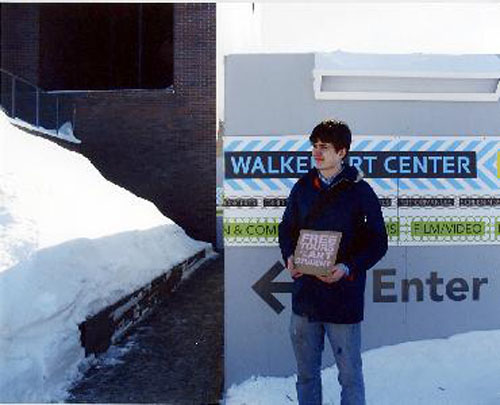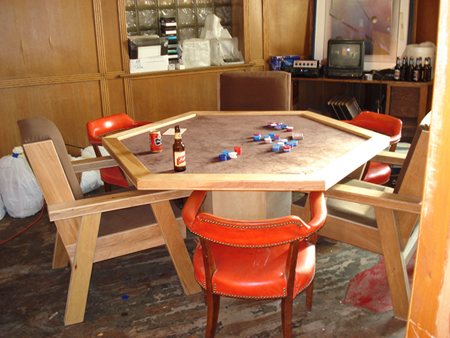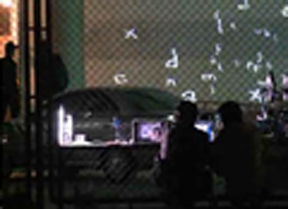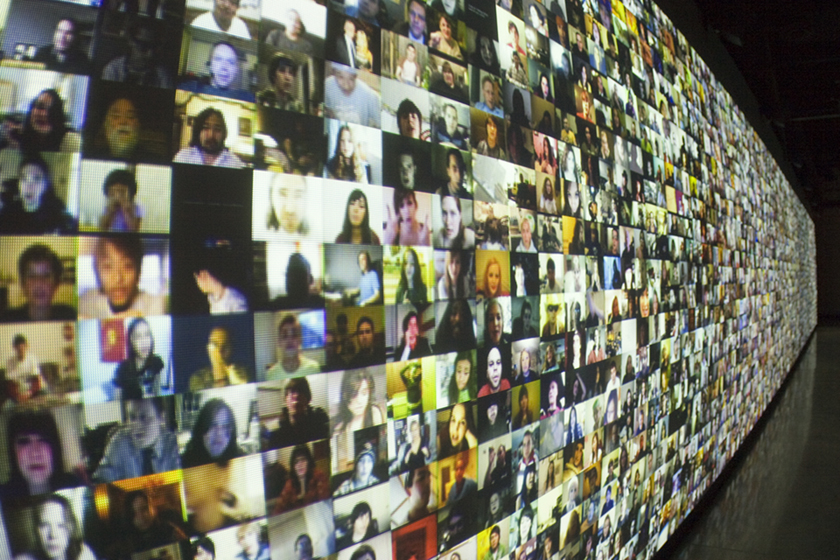Here are some images from Marina Zurkow of Will Pappenheimer’s and Chipp Jansen’s Tampa Public Mood Ring.
Liverpool Biennial seeks “Wonder Curator”
The Liverpool Biennial has a remarkable program of international public art commissions and is looking for a curator for this aspect of their program.
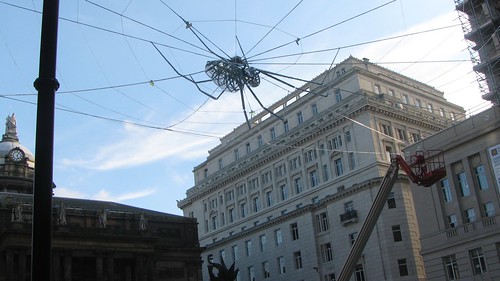
Ai Weiwei, Web of Light, Liverpool Biennial, 2008
The International Curator will work with the Director to design and deliver the International exhibition, directly and through our partners. This involves the research, commissioning, production and delivery of the non-venue based commissions. The curator must have the vision to commission works from the best international artists, build real collaboration with our various partners, and manage project teams to deliver our mission.
Closing date for applications
http://www.biennial.com/content/Footer/Opportunities.aspx
Lights on Tampa
I asked Marina Zurkow, whose Slurb is premiering at Lights on Tampa, to send Public Address some dispatches from the event.
Radiator Symposium: Exploits in the Wireless City
Broadway Media Centre, Nottingham UK
15 – 16 January 2009
As part of the 4th Radiator festival, the Radiator Symposium, “Exploits in the Wireless Cityâ€, aims to instigate discussion, debate and new interdisciplinary research networks based on the understanding that the development of digital networks are transforming our notion of (public and private) space.
Bringing together artists with architects, urban theorists, computer scientists, sociologists and fellow citizens, the symposium will explore, question and play with this new urban topography where the re-conceptualizing of the public sphere in the regeneration developments of the East Midlands mirror those around Europe.
Radiator will host the symposium alongside a series of presentations, exhibitions and discussions where the audience will have the opportunity to explore, remodel and re-present space in its traditional and emergent forms.
In its critique, the Radiator symposium will question the opportunities, future strategies and implementations that artists and communities face when learning to act within these new hybrid city spaces.
Through its artistic interventions, Radiator will put theory into practice with projects and events that both position and challenge the dominant forces at work in the urban environment and explore the new territories opened up by hybrid space. The “Going Underground†project, investigates this infrastructure by placing 5 artists into the urban confines of British cities: Glenn Davidson (Artstation) (UK), Folke Köbberling&Martin Kaltwasser (DE), Ian Nesbitt (UK), Christian Nold (UK), N55 (DK). These artists will act as sleeper agents, observing and gathering information from a range of different sources including; architects, planning departments, city council offices, surveillance, monitoring centre’s and the Police to create new work in response to their research.
There are still places left to book for the Radiator Symposium. For
Bookings, ring ++44(0)115 840 9272 or email info@radiator-festival.org
More info on http://www.radiator-festival.org/radiator-symposium-2009
- Final speaker list online now. Keynote speeches by Saskia Sassen (USA),Richard Barbrook (England), Duncan Campbell (England), JODI (NL). Complete speaker list on http://www.radiator-festival.org/participants
- Symposium Panel details can be downloaded here: http://www.radiator-festival.org/files/Radiator_SymposiumPanels.pdf
Lights on Tampa Artist Symposium
Thursday January 8, 2008
4-6 pm
Tampa Theater
711 N. Franklin St.

Marina Zurkow, animation still of “Slurb”, the installation proposed for outdoor projection at the St. Pete Times Forum for Lights On Tampa. Image courtesy of the artist.
This symposium will explore various issues including:
- How does the work of each artist function in the public realm?
- What do these artworks, and programs such as Lights On Tampa, say about today’s cultural environment both nationally and in a mid-size postindustrial city such as Tampa?
2009 Lights on Tampa Artists are:
- Casa Magica
- Chris Doyle
- Marina Zurkow
- Will Pappenheimer & Chipp Jansen
- Carlton Ward Jr.
Living City :: environmental responsiveness
The Living is a practice by David Benjamin and Soo-in Yang, which emphasizes open-source research and design, seeking collaboration both within and outside the field of architecture.
I saw their prototype for a responsive “breathing” building skin as part of the Vapor exhibition at Southern Exposure. As curators Jordan Geiger and Alison Sant wrote:
“Living City is a full-scale prototype building skin designed to breathe in response to air quality. David Benjamin and Soo-in Yang have been developing one of the first architecture prototypes to link local responses in a building to a distributed network of sensors throughout the city. The prototype will be exhibited at SoEx, opening and closing its gills in response to information the sensors collect.”

David Benjamin + Soo-In Yang, The Living City, prototype, installation view, Vapor, Souther Exposure. via Shotgun Review
The breathing facade is an R&D project, essentially, of a larger investigation about the “living city,” which they see as
- A platform for the future when buildings talk to one another
- An exploration of the vitality of the city through new forms of public space—air and facade
Or as they subtitle their explanatory video Buildings Talk, “From the old model of local input with local output … to the new model of local and global input with local and global output.”
River Glow
Another environmentally responsive project The Living has prototyped is River Glow, “a network of pods that float in public waterways, sense water quality, and send a signal visible from the water or on shore.”
Nuage Vert
River Glow, in particular, reminds me of HeHe’s Nuage Vert, which won the Green Prix for Environmental Art at the 2008 01SJ Biennial and is a literally spectacular effort to use responsive visualization to motivate the local population to change their electricity consumption patterns, thereby affecting the amount of pollution produced by a nearby powerplant.
Fade to Black
A more conceptual, less spectacular, but nonetheless important version of responsively visualizing environmental conditions was the Bureau of Inverse Technology’s BANGBANG network from 2000, in particular the Fade to Black [FTB] node or capability.
“Fade to Black is a network of webcams oriented skyward. Image on the webcam fades to black as pollutant film accumulates on the lens. Provides visual and empirical information on air quality; viewable in live stream or archived [concatanated] format. Test deployments: Houston TX, Hollywood CA, Bronx vs Broadway NYC. Additional sites/host computers being actively sought. This project is part of the BangBang camera network.”
The Lab at Rockwell Group
Former Minneapolitan Joshua Walton is a “New Media Lead” at the R&D Lab for the New York-based Rockwell Group, which has been doing some very interesting work in the public sphere.
In 2008, Rockwell Group, in collaboration with Jones + Kroloff, had the prestious assignment to design the entrance installation to “Out There: Architecture Beyond Building,†the main exhibition for the 11th annual Venice Architecture Biennale, an immersive and interactive environment constructed from iconic films.
I was particularly interested in their “Mauboussin Kaleidoscope,” for which they created an algorithmic kaleidoscope generator using live video of the boutique’s jewels, rear-projected on the 2nd and 3rd story windows of the building.
Mauboussin Kaleidoscope from labatrockwell on Vimeo.
Also of interest is their prototype installation at the Toronoto Sheraton, which involved three elements: a reactive frieze tryptich, a reactive mirror and digital ticker.
On a very different scale, Rockwell Lab created a totally knit environment for the Design Industries Foundation Fighting AIDS 2008 Dining By Design program.
Looking forward to see what the Lab works on in 2009.
“The Lab represents Rockwell Group’s mission of making. It is a mixing chamber of ideas encompassing digital interaction design, the material and image library, modeling and prototyping resources. The Lab provides a space for the 250 designers at Rockwell Group – who are also artists, sculptors, chefs, opera singers, architects, playwrights, and set designers – to collaborate to create a cross-disciplinary approach to design, and generate a cross-pollination of ideas. The ambition of Lab is to explore and promote understanding of the relationship between human interaction with technology, and its effect on experience. This activity includes: science and technology consultation, in house design and creation of interactive environments/objects, and maintaining networks of technology solution providers.”
The Language of Urbanism
Check out Wing Young Huie’s new blog at the Strib’s Your Voices.
“Your Voices features unique perspectives from members of your community. Here you’ll find commentary on current events, public issues and day-to-day life in Minnesota.”
Wing’s first two entries in the blogosphere are “Good Morning America” and “Found In Translation.”
Huie is currently photographing the neighborhoods connected by University Avenue in St. Paul for a six-mile installation in 2010, and both entries are from that project, “The Language of Urbanism: A Six-Mile Photographic Inquiry.” In words words as “documentary” as his images, Huie tells the story of a local – and implicitly or explicitly, his intersection with that story.
“It’s been 12 years since he retired as a Hennepin County caretaker for mentally ill adults, but his days are packed with volunteer work and a busy social life. He never married and has no siblings or children. ‘I’m still hoping,†he says.’ For a while he had a button that read, ‘Looking for a sugar momma,’ but didn’t get any bites.”
“Until recently he had been an engineer in China making good money and was now in St. Paul looking for work. Anything, he said, even washing dishes. I met him at the Hubbs Center in St. Paul where he was learning English. I asked if I could photograph him for my University Avenue Project, but it was difficult because my Chinese was worse than his English.”
Public/Private in “Pay Attention”
Hitching Up to Public Art
How can you not love this experiment with art in public places?
btw, here is the San Jose version of Portland’s horse project. In San Jose the local constabulary like to hitch up to public art when they stop for a latte at Starbucks. 😉
[deli.ci.us bookmarks] 11.29.08
It’s a translation thing?
This summer I participated in a workshop at Creative Capital on “Exhibiting and Working with Institutions.” Somewhat tongue-in-cheek, I posited that at least in “emerging fields” there may be a translation problem between what an artist says and what a curator hears. The language is specific to the art formerly known as new media, but it may also apply, at least in spirit, to experiments with art in public places.
What you say: I’m a new media artist
What they hear/think:
-
A. You’re a technophiliac who doesn’t understand contemporary art.
B. Maybe he can fix my email.
C. It’s not real art.
What you say: The process is as important as the end product.
What they hear/think:
-
A. Has a hard time meeting deadlines.
B. We’ll have a page on the website that explains the process.
C. It’s not art.
What you say: The work is only completed by the audience; it’s participatory.
What they hear/think:
-
A. No quality control.
B. It will drive our guards crazy, if the visitors can touch the art.
C. It’s not really art.
What you say: It’s research.
What they hear/think:
-
A. Still trying to figure out what to do.
B. It’s boring and academic.
C. It’s not really art.
What you say: My work is open source.
What they hear/think:
-
A. I’ll take two this month.
B. Does that mean anybody can do it?
C. It’s not really art.
What you say: It’s online.
-
A. That’s cheap.
B. No one will see it anyway, so why not.
C. It’s not really art.
What you say: It’s new and innovative.
What they hear/think:
-
A. THAT will burnish our image as a cutting edge organization.
B. I bet we can get a ton of funding from some tech company, can’t we?
C. It’s not really art
What do you say/hear/think in your experience?
The full text of the talk is here.
The t-shirt as public art
Dispatch: Cloth, print and the political
threewalls
Exhibition: February 20th – March 27th, 2009
In conjunction with the Southern Graphics Council Conference, threewalls is hosting an exhibition of political prints on cloth and we’re looking for your DIY election T-shirts!
The T-shirt, arguably considered an American invention, insofar as it is worn as one’s primary garment, and not an undershirt, became a substrate for advertising and political support in the 1950s. Since then it has played an invaluable role in the promotion of politics, sub-culture, music, leisure activities, businesses, sports team, personal slogans and more. The T-shirt is the walking, talking billboard – and probably still the most effective and inexpensive way to get a message out!
Perhaps in concert, printmaking and DIY are experiencing a significant revival. As an inexpensive medium for mass-producing a message or artwork, the hand-pulled print is making a major re-appearance as the most distinct way to promote bands, indie-movies, craft fairs, art events, book releases and rallies. The silk-screened T-shirt shares this appeal. As the election year heated up, the number of small-run T-shirts, printed by individual crafters and print collectives or one-offs by artists, designers or hobbiests ballooned. Nothing could be more American about the T-shirt as a vehicle for rhetoric: casual, commercial and accessible.
Dispatch is an exhibition of grass-roots political efforts, the millennial DIY ethic, micro-capitalism and the intersection between the commercial and craft in print media. As a document of the hundreds of T-shirts that were designed and printed by individuals (for their own use or to sell at craft fairs or raise money for campaigns), Dispatch makes visible, en masse, both the artistry and sheer multitude of designs that were made in support of the 2008 presidential and associated campaigns.
Chicago, both the root of the president-elect Obama’s campaign and a city with a strong grass-roots ethic in both the arts and politics, is a natural host to this exhibition. Dispatch draws on this, celebrating both the artistry and efforts of these makers, while drawing attention to how artwork and micro-industry became both an important form of participation in the millennial political process as well as a highlighting how the 2008 presidential campaign both appealed to and drew on millennial DIY culture.
As a companion to the exhibition and archive of the work, a catalog of the work featured at the gallery, with profiles and stories on a selection of artists about their prints, why they made them, where they wore them and how their garments may have made an impact on their community will be available.
Please submit designs made to support your candidate for office or made as political commentary during the primaries or the general election about the candidates, the election or the policies being discussed. Jpegs should be sent by January 15th, 2009 to Shannon Stratton at shannon@three-walls.org with your contact information and a short description of your T-shirt: where it was made, how many you made, how often you wore it, if you gave away or sold any of the shirts.
threewalls is a nonprofit 501(c)3 organization dedicated to contemporary art practice and discourse. Through the residency program(s), SOLO project and quarterly publication Paper and Carriage, threewalls aims to provide opportunities for experimentation, chance, critical dialogue and context for artists, curators and writers who are at pivotal points in their careers.
Shannon Stratton
Director and Chief Curator of Programs
ThreeWalls
119 N Peoria 2D
Chicago, IL
312-432-3972
Northern Lights founder profiled
Northern Lights is in the U of M news recently with a profile of director Steve Dietz:
Dietz’s current project is called Northern Lights: a roving, collaborative, interactive media-oriented art agency. “There are some exceptional artists here,†he says, “and there are some strong programs at MCAD and the U; but there isn’t the strong environment of support that you get in San Francisco and New York.†This is one of the reasons that Northern Lights includes a program called Art(ists) on the Verge (AOV), a two-track fellowship and mentoring program for Minnesota-based, emerging artists working experimentally at the intersection of art and technology, with a focus on practices that are social, collaborative and/or participatory. AOV is a partnership project between Northern Lights and the Jerome Foundation. Northern Lights was also the initiator of the UnConvention, a coordinated effort of artists’ responses to the 2008 Republican National Convention.
via Betsy Mowry, TC Daily Planet
Improv Everywhere goes to Russia
I’m sorry, I just love these experiments with art in public places by Improv Everywhere.
